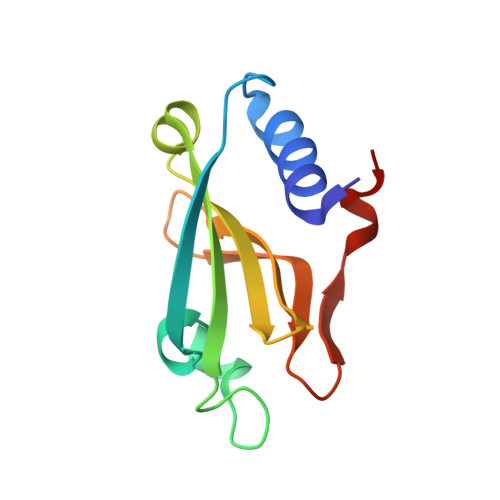Staphylococcus aureus protein SAUGI acts as a uracil-DNA glycosylase inhibitor.
Wang, H.C., Hsu, K.C., Yang, J.M., Wu, M.L., Ko, T.P., Lin, S.R., Wang, A.H.J.(2013) Nucleic Acids Res 42: 1354-1364
- PubMed: 24150946
- DOI: https://doi.org/10.1093/nar/gkt964
- Primary Citation of Related Structures:
3WDF, 3WDG - PubMed Abstract:
DNA mimic proteins are unique factors that control the DNA binding activity of target proteins by directly occupying their DNA binding sites. The extremely divergent amino acid sequences of the DNA mimics make these proteins hard to predict, and although they are likely to be ubiquitous, to date, only a few have been reported and functionally analyzed. Here we used a bioinformatic approach to look for potential DNA mimic proteins among previously reported protein structures. From ∼14 candidates, we selected the Staphylococcus conserved hypothetical protein SSP0047, and used proteomic and structural approaches to show that it is a novel DNA mimic protein. In Staphylococcus aureus, we found that this protein acts as a uracil-DNA glycosylase inhibitor, and therefore named it S. aureus uracil-DNA glycosylase inhibitor (SAUGI). We also determined and analyzed the complex structure of SAUGI and S. aureus uracil-DNA glycosylase (SAUDG). Subsequent BIAcore studies further showed that SAUGI has a high binding affinity to both S. aureus and human UDG. The two uracil-DNA glycosylase inhibitors (UGI and p56) previously known to science were both found in Bacillus phages, and this is the first report of a bacterial DNA mimic that may regulate SAUDG's functional roles in DNA repair and host defense.
Organizational Affiliation:
Institute of Biological Chemistry, Academia Sinica, Taipei 115, Taiwan, Graduate Institute of Translational Medicine, College of Medical Science and Technology, Taipei Medical University, Taipei 110, Taiwan, Institute of Bioinformatics and Systems Biology, National Chiao Tung University, Hsinchu, 30050, Taiwan, Department of Biological Science and Technology, National Chiao Tung University, Hsinchu, 30050, Taiwan, Center for Bioinformatics Research, National Chiao Tung University, Hsinchu, 30050, Taiwan and Core Facilities for Protein Structural Analysis, Academia Sinica, Taipei 115, Taiwan.















